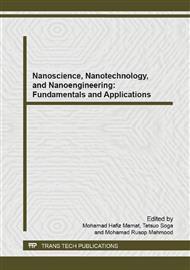[1]
J. Prasek and M. Adamek, Development of new thick film sensor for heavy metals detection, Proceedings of IEEE, (2004) 749-752.
DOI: 10.1109/icsens.2004.1426276
Google Scholar
[2]
F. C. Seman and R. Cahill, Performance enhancement of Salisbury screen absorber using resistively loaded spiral FSS, Microwave and Optical Technology Letters, 53 (2011) 1538-1541.
DOI: 10.1002/mop.26040
Google Scholar
[3]
N. Maleki, A. Safavi, and F. Tajabadi, High-Performance Carbon Composite Electrode Based on an Ionic Liquid as a Binder, Analytical Chemistry, 78 (2006) 3820-3826.
DOI: 10.1021/ac060070+
Google Scholar
[4]
C. F. Soon, W. I. W. Omar, N. Nayan, H. Basri, M. B. Narawi, and K. S. Tee, A Bespoke Contact Angle Measurement Software and Experimental Setup for Determination of Surface Tension, Procedia Technology, 11 (2013) 487-494.
DOI: 10.1016/j.protcy.2013.12.219
Google Scholar
[5]
M. Żenkiewicz, Methods for the calculation of surface free energy of solids, Journal of Achievements in Materials and Manufacturing Engineering, 24 (2007) 137-145.
Google Scholar
[6]
H. W. Fox and W. A. Zisman, The spreading of liquids on low energy surfaces. I. polytetrafluoroethylene, Journal of Colloid Science, 5 (1950) 514-531.
DOI: 10.1016/0095-8522(50)90044-4
Google Scholar
[7]
R. Weast, Handbook of tables for applied engineering science, The Chemical Rubber Co., Cleveland, OH, (1970) 9.
Google Scholar
[8]
D. Kwok, A. Leung, C. Lam, A. Li, R. Wu, and A. Neumann, Low-rate dynamic contact angles on poly (methyl methacrylate) and the determination of solid surface tensions, Journal of colloid and interface science, 206 (1998) 44-51.
DOI: 10.1006/jcis.1998.5610
Google Scholar
[9]
E. G. Shafrin and W. A. Zisman, Critical surface tension for spreading on a liquid substrate, The Journal of Physical Chemistry, 71 (1967) 1309-1316.
DOI: 10.1021/j100864a020
Google Scholar
[10]
D. Kwok and A. Neumann, Contact angle measurement and contact angle interpretation, Advances in colloid and interface science, 81 (1999) 167-249.
DOI: 10.1016/s0001-8686(98)00087-6
Google Scholar
[11]
Physical Properties of Liquids, Datasheet
Google Scholar
[12]
T. Thomson, Design and Applications of Hydrophilic PolyurethanesCRC Press, 2010.
Google Scholar
[13]
J. H. Walther, R. Jaffe, T. Halicioglu, and P. Koumoutsakos, Carbon nanotubes in water: structural characteristics and energetics, The Journal of Physical Chemistry B, 105 (2001) 9980-9987.
DOI: 10.1021/jp011344u
Google Scholar
[14]
R. M. Zin, C. F. Soon, S. Ghadafi, M. Ali, R. Ahmad, and N. Nafarizal, Fabrication and Characterisation of the Electrical and Physical Properties of the Mask Printed Graphite Paste Electrodes on Paper Substrates, Advanced Materials Research, 925 (2014) 510-513.
DOI: 10.4028/www.scientific.net/amr.925.510
Google Scholar
[15]
S. Vowell, Microfluidics: the effects of surface tension, (2009).
Google Scholar
[16]
K. Grundke, S. Michel, and M. Osterhold, Surface tension studies of additives in acrylic resin-based powder coatings using the Wilhelmy balance technique, Progress in Organic Coatings, 39 (2000) 101-106.
DOI: 10.1016/s0300-9440(00)00129-6
Google Scholar


